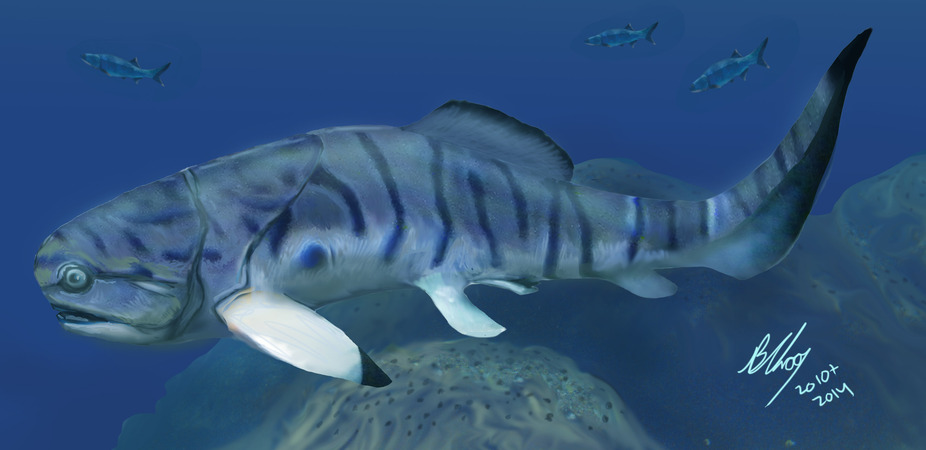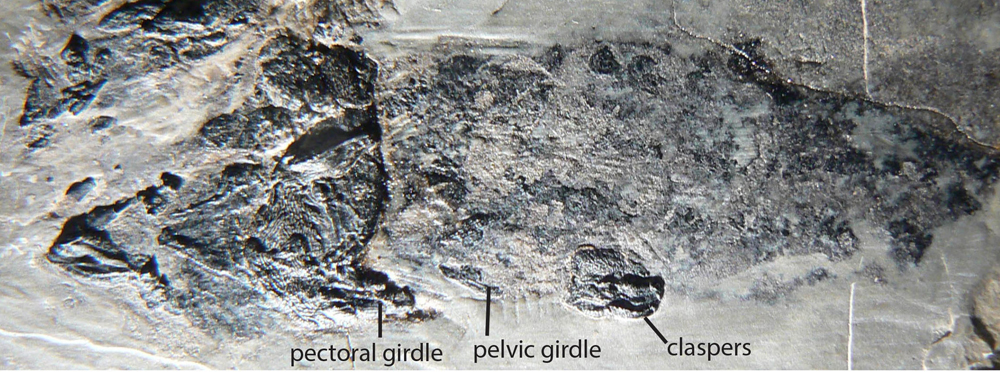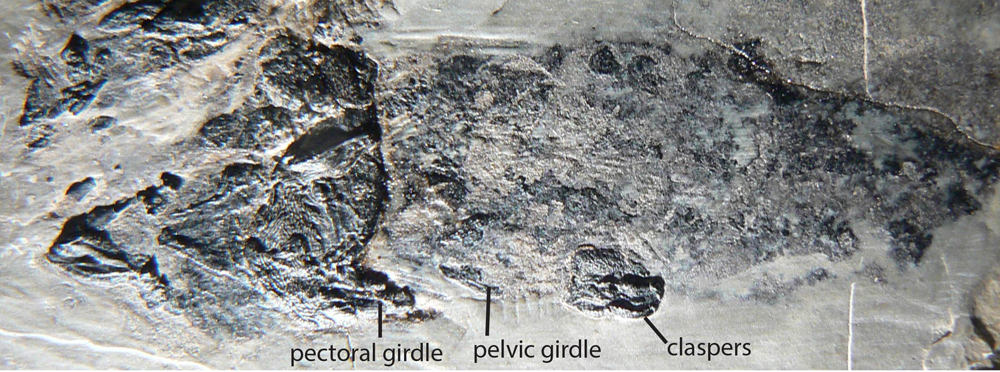
The First Vertebrate Sexual Organs Evolved as an Extra Pair of Legs

This article was originally published at The Conversation. The publication contributed the article to Live Science's Expert Voices: Op-Ed & Insights.
We humans use the euphemism for sex that “we like to get a leg over” but the first jawed vertebrates – the placoderms – they liked to get a leg in.
They were the first back-boned creatures to evolve male genital organs, or claspers, supported by a bony internal skeleton.
What’s even more peculiar is that, unlike the cartilaginous claspers of modern sharks, which are a modified part of the pelvic fin, our new research has shown that in placoderms they were basically a separate set of paired appendages.
The reign of the placoderms
Placoderms had thick bony plates enveloping the head and trunk regions. They ruled the seas, rivers and lakes of the world for 70 million years, becoming extinct around 360 million years ago.
Placoderms were the world’s first megapredators, with ancient behemoths such as Dunkleosteus reaching the same size as today’s Great White Shark.
They were also the first vertebrate animals on Earth to have a complex form of sexual reproduction – copulation – where males fertilised the females internally rather than just spawning in water.
Sign up for the Live Science daily newsletter now
Get the world’s most fascinating discoveries delivered straight to your inbox.
To achieve this, the males bore bony paired structures – the claspers – which were previously thought to be similar to the cartilaginous claspers of modern sharks.
For many years placoderms were thought of as “shark-like fishes” and so their anatomy was routinely interpreted using sharks as a model. This approach has shadowed the secret of their true evolutionary significance for almost the past century.

Hints of hidden genitals
The first hint that placoderm fishes were sexually dimorphic (meaning males look different to females) was seen in the different pelvic fins by English palaeontologist David M.S. Watson in the 1930s. He studied a placoderm fish called Rhamphodopsis that lived around 390 million years ago in Scotland.
In the 1960s Norwegian palaeontologist Tor Ørvig studied a similar kind of placoderm (a ptyctodontid) named Ctenurella and went one step further. He identified the strange structures near the pelvic fins as claspers, implying they were intromittent or insertable organs.
Nonetheless, just identifying these structures doesn’t mean the fishes actually used them to internally fertilise the females.

The first hard evidence that placoderms really did copulate was when our team announced in 2008 that we had found complete embryos in perfectly preserved fossil specimens from the Gogo Formation of Western Australia.
These were found in just one group of placoderms called ptyctodontids, which showed sexual differences in the pelvic region.
We found further embryos in the largest group of placoderms – the arthrodires – in 2009 and later that same year identified the first male copulatory organs in this group.
Evidence there all the time
Our new study shows that many other common species of placoderm also had similar complex reproductive organs. The evidence was sitting in museum collections around the world but not noticed until one of us (Kate Trinajstic) went searching for and found them.
Our research has shown that the mating organs of the ancient placoderms were rather complex. The review of the reproductive structures in placoderms produced many new examples which showed an unusual pattern emerging.
One specimen even showed an unborn embryo with a tiny clasper developed, so we could tell it was a male.

Unlike the claspers of modern sharks and rays that are a part of the paired pelvic fins, the claspers and female basal plates in placoderms were not at all connected to that fin.
Instead they developed as an extra pair of limbs further down the body.
This discovery implies that the first vertebrates did not conform to the typical tetrapod-like pattern of having just two pairs of paired limbs (arms, or pectoral fins, and legs, or pelvic fins) that typifies the basic jawed vertebrate body pattern from fishes through to mammals.
The implications of this study mean that the similar looking male claspers in placoderms and sharks are actually not the same structures, but most likely evolved independently.
As the bony placoderm claspers were not rigidly fixed to the pelvic fin, they would have been able to rotate forwards, so the earliest sexual mating position was likely to have been a missionary one.

The claspers in placoderms can now be regarded as a serial homologue or gradual development of the other paired appendages - an extra pair of legs, so to speak.
The mechanism for how this happens is clear. Certain homeobox (hox) genes control the repetition of structures such as limbs (as in the sonic hedgehog gene) and the position of them on the body axis (the hox genes tbx4, tbx5).
In the case of placoderms, the zone of competence to form paired appendages was much enlarged compared to modern vertebrates, and extended beyond the pelvic fins, enabling an extra pair of structures to develop.
In sharks the pelvic fins became elongated and modified as claspers using a different set of hox genes (hoxd13) .
This new discovery implies that the so-called primitive way of vertebrate reproduction – spawning in water – changed dramatically to copulation almost as soon as vertebrates had the right tools for the job.
Jaws appeared around the same time as claspers in placoderms, and so might also have been connected to this early reproductive behaviour in some way.
Grey Reef Sharks Mating. Dracon Mounier
In addition to aiding in the capture of prey, feeding and ventilation, jaws may also have been utilised for holding on to a partner whilst mating, as many sharks do today (video, above).
Clearly we don’t know the full story yet. There is still a lot more to discover about this fascinating group of ancient extinct fishes.
John Long receives funding from the Australian Research Council.
Kate Trinajstic receives funding from Australian Research Council.
This article was originally published on The Conversation. Read the original article. Follow all of the Expert Voices issues and debates — and become part of the discussion — on Facebook, Twitter and Google +. The views expressed are those of the author and do not necessarily reflect the views of the publisher. This version of the article was originally published on Live Science.

John Long researches the early evolution of vertebrates in order to unravel the stages of how the modern vertebrate body plan evolved. He has served as the Vice President of Research and Collections at the Natural History Museum of Los Angeles County, Head of Sciences at Museum Victoria and as Curator of Vertebrate Palaeontology at the Western Australian Museum. Long has conducted field work collecting fossils in Australia, Antarctica , Southeast Asia, The US, Iran, South Africa and China. He is also author of some 30 adult and children's books, including non-fiction and fiction.









